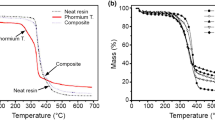Abstract
The compressive strength of unidirectional flax fibre epoxy composites was studied. The compressive strength is influenced negatively by the presence of kink bands in the flax fibres. Improvement of the adhesion between the fibres and the epoxy resin can be achieved easily by removing the thin wax layer which covers the surface of the flax fibres. However, improving the adhesion between fibres and matrix only improves the compressive strength to a very limited extent. Stabilisation of the kink bands present in the fibres and improvement of the compressive properties of the fibres can be achieved by impregnating the fibres with melamine formaldehyde (MF) resin. This results in a large increase in the compressive strength of the resulting composite. The increase in compressive strength is proportional to the amount of MF resin present in the composite. However, the presence of the resin in the fibres lowers their tensile strength, and subsequently the tensile strength of the resulting composite.
Similar content being viewed by others
References
D. Hull, “An introduction to Composite Materials” (Cambridge University Press, Cambridge, UK, 1981).
H. L. Bos, M. J. A. Van Den Oever and O. C. J. J. Peters, J. Mater. Sci. 37 (2002) 1683.
M. Karus, M. Laup and D. Lohmeyer, Study on Markets and Prices for Natural Fibres (Germany and EU), Nova Institute, March 2000, FNR-FKZ:99NR163.
R. Heijenrath and T. Peijs, Adv. Comp. Lett. 5 (1996) 71.
H. L. Bos and A. M. Donald, J. Mater. Sci. 34 (1999) 3029.
R. O. Herzog, “Der Flachs” in “Technologie der Textilfasern” (Julius Springer, Berlin, 1930).
G. J. Mcdougall, Carbohydr. Res. 241 (1993) 227.
T. A. Gorshkova, S. E. Wyatt, V. V. Sal'Nikov, D. M. Gibeaut, M. R. Ibragimov, V. V. Lozovaya and N. C. Carpita, Plant Physiol. 110 (1996) 721.
C. Mooney, T. Stolle-Smits, H. Schols and E. De Jong, J. Biotechn. 89 (2001) 205.
V. V. Sal'Nikov, M. V. Ageeva, V. N. Yumashev and V. V. Lozovaya, Russ. Plant Physiol. 40 (1993) 416.
T. A. Gorshkova, V. V. Sal'Nikov, N. M. Pogodina, S. B. Chemikosova, E. V. Yablokova, A. V. Ulanov, M. V. Ageeva, J. E. G. Van Dam and V. V. Lozovaya, Annals of Botany 85 (2000) 477.
I. P. Thiery, J. Microsc. 6 (1967) 987.
J. M. Van Hazendonk, E. J. M. Reinerink, P. De Waard and J. E. G. Van Dam, Carb. Res. 291 (1996) 141.
P. E. Kolattukuty and K. E. Espelie, in “Biosynthesis and Biodegradation of Wood Components,” edited by T. Higuchy (American Academic Press, Orlando, FL, USA, 1985).
W. H. Morisson, D. E. Akin, D. S. Himmelsbach and G. R. Gamble, J. Sci. Food Agric. 79 (1999) 3.
W. H. Morisson and D. D. Archibald, J. Agric. Food Chem. 46 (1998) 1870.
K. Van De Velde and P. Kiekens, Ang. Makromol. Chemie 272 (1999) 87.
J. M. Van Hazendonk, J. C. Van Der Putten, J. T. F. Keurentjes and A. Prins, Coll. Surf. A 81 (1993) 251.
C. Morvan, A. Jauneau, A. Flaman, J. Millet and M. Demarty, Carb. Res. 13 (1990) 149.
O. M. Astley and A. M. Donald, Biomacromolecules 2 (2001) 672.
P. NÄsslund, R. Vuong, H. Chanzy and J. C. JÉsior, Textile Res. J. 58 (1988) 414.
H. H. Wang, J. G. Drummond, S. M. Reath, K. Hunt and P. A. Watson, Wood Sci. Tech. 34 (2001) 493.
C. Y. Liang and R. H. Marchessault, J. Polym. Sci. 39 (1959) 269.
J. M. Felix, P. Gatenholm and H. P. Schreiber, Polym. Comp. 14 (1993) 449.
M. H. B. Snijder and H. L. Bos, Comp. Interf. 7 (2000) 69.
J. M. Felix and P. Gatenholm, J. Appl. Pol. Sci. 42 (1991) 609.
A. O. Rapp, H. Bestgen, W. Adam and R.-D. Peek, Holzforschung 53 (1997) 111.
A &; F bv, unpublished results.
Compressive modulus measurements on 50 wt% flax fibre composites with various type of epoxy resin all yield a compressive stiffness between 30 MPa and 34 MPa, as published in: Final Report of the BLADECO project, EET, Utrecht, The Netherlands (2002).
B. Lamy and C. Pomel, J. Mater. Sci. Lett. 21 (2002) 1211.
K. Van De Velde and P. Kiekens, Macromol. Mater. Eng. 286 (2001) 237.
D. G. Hepworth, J. F. V. Vincent, G. Jeronimidis and D. M. Bruce, Composites Part A 31 (2000) 599.
Author information
Authors and Affiliations
Rights and permissions
About this article
Cite this article
Bos, H.L., Molenveld, K., Teunissen, W. et al. Compressive behaviour of unidirectional flax fibre reinforced composites. Journal of Materials Science 39, 2159–2168 (2004). https://doi.org/10.1023/B:JMSC.0000017779.08041.49
Issue Date:
DOI: https://doi.org/10.1023/B:JMSC.0000017779.08041.49




